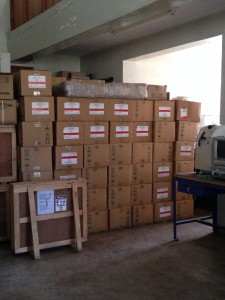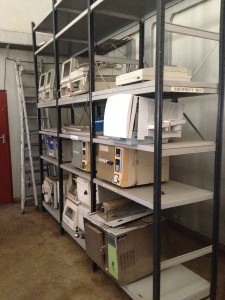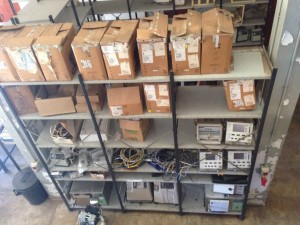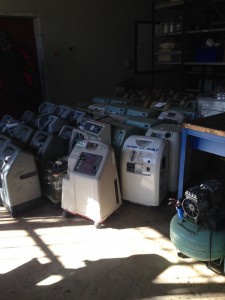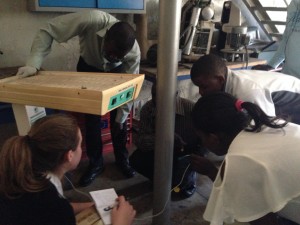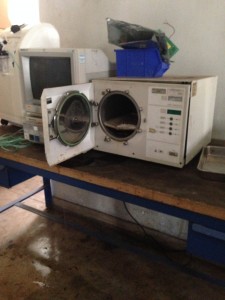As I briefly mentioned in my post about the Poly interns, we were excited to meet with the Physical Assets Management (PAM) engineers to better understand their role in the hospital system as well as to see if there was a potential for collaboration between the PAM office and the Poly. In the process, I learned much more about the challenges PAM engineers face on a daily basis as they try to repair and maintain all of the equipment across Queens and 6 surrounding district hospitals.
Walking into PAM is a bit of an overwhelming scene. Outside their warehouse sit 9 or 10 hospital bed frames broken and awaiting repair. Upon entering the building, we were greeted with hundreds of boxes of donated neck collars that the hospital had no space or use for, so they had been sent to PAM for storage indefinitely.
Boxes of 4,000 soft neck collars fill the entryway to PAM. These collars were donated from India in 2011, but PAM was the only spot that had enough space to store them while the hospital tried to identify a use for them.
Suction pumps, ventilators, heat lamps, and autoclaves in need of servicing fill the warehouse shelves, and an army of nonfunctioning oxygen concentrators cover about a fifth of the floor space:
We met with one of the head engineers in the office, and he gave us a tour of the workspace. Since we were with the Poly interns, this tour was incredibly helpful for better understanding the common breaks that PAM sees in the hospital’s most-used equipment.
For example, Queens already runs on a limited supply of suction pumps due to lack of availability, but these machines are also subject to frequent breaks because they lack an alarm system to alert nurses that the container is filled with fluids and must be emptied. The machine then continues to suction, the container overflows, and the fluids flood the motor. For a nurse whose attention must be split across patients and procedures, something as simple as an audible alert when the container is reaching its capacity could be the difference that avoids the machine needing 2-month repair stint at PAM. In addition, a shut-off mechanism could provide a fail-safe in case the nurse is unable to attend to the overfilled container in time. These types of design ideas gave the Poly interns great material with which to start a design project that would fill a real-world need at Queens, not only helping clinicians get more out of their machines, but also reducing some of the repair load that falls on PAM.
Francis, Christina, and Sarah look on as Joseph explains how radiant warmers in the nursery use temperature to regulate a baby’s body temperature. If the probe malfunctions and misreads ambient temperature, the warmer can under or overheat the infant.
In an ideal world, PAM would be able to perform quarterly checks on all hospital equipment both at Queens and at the 6 district hospitals it services. However, these checks would take 4-5 staff members about 3-4 days per hospital, per quarter. In terms of funding and staff availability, these standards are oftentimes impossible, so the challenge then becomes how to get the most out of preventative maintenance by the in-hospital maintenance departments.
Another approach could be more useful instruction for clinicians and nurses on day-to-day care for the machines. While engineers must have an in-depth knowledge of a technology, the user requires a much more basic understanding of key points to extend viability and proper functioning of a device. For example, understanding that running an autoclave (used to sterilize surgical or other procedural equipment between patients) without water covering the heating element can permanently ruin the heating element is one instance where user knowledge prolongs the lifetime of a machine and keeps PAM from having to perform a costly, time-intensive repair.
An autoclave with a damaged heating element sits in PAM for the foreseeable future until they are able to acquire a replacement element from the procurement office.
So while the procurement of repair parts and availability of trained engineers present very real constraints for PAM, having an understanding of the upstream causes of machine breakdown can provide options that in the long run can work within these limitations to increase PAM’s ability to serve Queens and its surrounding district hospitals.
